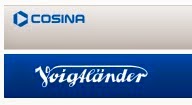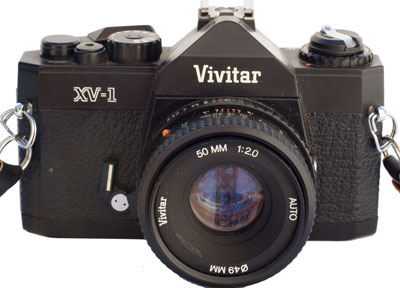Die Cosina CT-1 von 1979 ist einer speziellen Weise eine besondere Kamera
und sollte in keiner ernsthaften SLR Sammlung fehlen. Sie ist das Destillat
von 4 Jahrzehnten SLR-Entwicklung und vereint alle jene Komponenten,
Materialien und Designmerkmale, die sich in dieser Zeit gegenüber ihrer
jeweiligen Konkurrenz durchgesetzt haben. In einem Wort: die GENERISCHE
Spiegelreflex.
In a special way Cosina's CT-1 from 1979 is an outstanding camera and should not be missing in
any serious SLR collection. It is the distillate from 4 decades SLR
development and combines all those components, materials and design
features that have prevailed during this period compared to their respective
competitors. In a word, the GENERIC SLR.
Sie hat alle wesentlichen Funktionen, die man Ende der 70er von einer SLR
erwartete, und auch alle Bedienelemente dort, wo man sie vermutete.
Gleichzeitig verzichtet sie auf alles Besondere. Die Kamera hat tatsächlich
nichts, was an anderen Kameramodellen nicht schon ausprobiert und optimiert
worden wäre.
It has all the essential features that one expected from an
SLR at the end of the '70ies'. Also all the controls are where they are susposed to be. At the same time
it has nothing special. The camera actually does not have anything that
would not have been tried and optimized on other camera models already .
Cosina
startete als optischer Betrieb und betrat die Bühne der Kamerabauer erst
1973, zu einem Zeitpunkt als andere gerade die Segel strichen (Besonders
die deutsche Kameraindustrie, aber auch japanische Firmen wie
Topcon,
Miranda
und andere, die keiner heute mehr kennt). Die Familie Kobayashi starte mit
(ebenfalls generischen) M42 Modellen und guckte sich das jeweils Beste von der
Konkurenz ab. Konsequenterweise wechselte man 1978 zum (lizenzfreien)
Pentax K-Bajonett, von dem viele damals glaubten es würde sich zum
allgemein akzeptierten Industriestandard mausern. Mit diesen generischen
Kameras hatte die Firma Cosina aber schnell ihre Bestimmung gefunden: Als
kleiner, flexibler und unabhängiger Hersteller bot man internationalen
Vertriebsgesellschaften an, genau diese Durchschnittkameras unter anderen
Markennamen zu bauen (erster Coup). DieListe
der Kameras, die Cosina unter anderem Namen hergestellt hat ist recht
umfangreich und die allermeisten basieren auf diesem CT-1 Grundmodell. Im
Laufe der Zeit kam ein schnellerer Copal Verschluss (bis 1/2000 s) zum
Einsatz, das Grundprinzip blieb und kann am Besten an der Anordnung der
drei charakterischen Bedienelemente Schnellspannhebel, Auslöser und
Zeitenrad erkannt werden.
Cosina
started as an optical factory and did not enter the scene of the camera producers until
1973, at a time when others just gave in (especially the German camera
industry, but also Japanese companies like Topcon , Miranda and
others that no one knows anymore today). The Kobayashi family started with (also
generic) M42 models and copied the best features from the respective competition.
Consequently, they changed in 1978 to the Pentax K-bayonet (public doamain), which many
at the time believed to become the generally accepted industry
standard. With these generic cameras the Cosina people quickly found
their destiny: As a small, flexible and independent producer they offered
to build cameras for international distributors, using their brand names (first coup). The list of
cameras that Cosina produced under different names is quite long
and the vast majority are based on this CT-1 base model. Over time,
a faster shutter (Copal, up to 1/2000 s) was used. The basic principle remained the same
and can be detected best by the arrangement of the three charakteristic
controls: quick-release lever, trigger and shutter speed dial.
Als die Ära der klassischen SLR's ab Ende der 1980er durch die neue AF-Generationen abgelöst wurde, entschlossen
sich schließlich die großen Kamerahersteller, zumindest ein klassisches
Modell im Programm zu halten, um ihre alte umfangreiche Objektivpalette
weiter zu unterstützen. Sie suchten also einen Lohnfertiger für die Kameras
und fanden: Cosina (zweiter Coup). So kommt es, dass sich Nikon
FE10/FM10, Canon T60, Olympus
OM2000 und andere alle technisch auf die CT-1 zurückführen lassen
und mit ihren jeweiligen Markenschwestern nicht viel mehr gemein haben als
das jeweilige Bajonett und den Namen auf dem Prisma. Pentax und Minolta
wählten einen anderen Weg und verschoben ihre alten Werkzeugmaschinen nach
China und produzierten dort Kameras wie die K-1000 und X-370. Die K-1000 ist übrigens bei fast identischer
Spezifikation einer der wichtigsten Konkurenten zur Cosina CT-1 und ihren
Zwillingsschwestern.
As the era of classical SLR's from the late 1980s has been replaced by the new AF generation,
the major camera manufacturers decided to keep at least one classical model
in the portfolio, to support the old range of non AF-lenses a little longer. Therefore they looked for a contract manufacturer for the cameras and found:
Cosina (second coup). It happens that Nikon FE10 /
FM10 , Canon T60 , Olympus
OM2000 and others all can be technically traced back to the CT-1
and do not have much more in common with their brand sisters than the
respective bayonet and the name on the prism. Pentax and Minolta chose
another path and moved their old production tools to China and produced cameras like the K-1000 and X-370th over there. The K-1000 is a way with an almost identical
specification the closest competitor to Cosina's CT-1 and its twin sisters.
Cosina's dritter Coup und der Grund, warum sie als Hersteller
mechanischer Kameras im Zeitalter der Digitalfotografie immer noch
existieren, ist die Sache mit Voigtländer (ich hatte es hier schon mal erwähnt...). 1999 erwarb
man nämlich teilweise Namensrechte an der ältesten Fotomarke der Welt
und stellte auf Basis des CT-1 Chassis eine manuelle Messsucherkamera vor,
die es mit Leica's M Serie aufnehmen sollte. Man hatte wohl richtigerweise
geahnt, dass mit der digitalen Fotorevolution manuelle Filmkameras wohl
langfristig nur noch in einer (und genau dieser) Nische existenzfähig sind.
Sogar Carl Zeiss sprang noch auf diesen Zug auf und bot zeitweise eine eigene, angeblich hochwertigere Messsucherkamera
an. Bitte mal raten, wer diese im Auftrag produziert hat: Cosina! Auch gab
es zeitweise eine Voigtländer Bessaflex SLR mit M42 Gewinde, richtig: auch hier steckt die
CT-1 noch drin.
Cosina's third coup and the reason why they still exist as a manufacturer of mechanical
cameras in the age of digital photography, is the story around
Voigtländer (I had mentioned it here before). In 1999 they acquired partially the name rights for the oldest photo brand of the world. On the basis of the CT-1 Chassis they presented manual rangefinder
cameras to take on Leica's M series. Cosina's assumption probably was correct that manual film cameras can only survive in one (and exactly this) niche during the digital photo revolution. Even
Carl Zeiss jumped on the train and offered its own, supposedly better quality rangefinder camera.
Please guess who produced it on Zeiss' behalf: Cosina! Also, for a short time there was a Voigtlander Bessa
Flex SLR with M42 thread, again the CT-1 was its basis.
Eine persönliche Geschichte zur Kamera muss ich aber auch noch loswerden.
Im Mai 1982, als ich meine allererste SLR erwarb (Nikon
EM) kaufte auch mein damals bester Freund sich seine SLR Ausrüstung:
eine Vivitar XV-1 (genau, eine Fremdmarken CT-1) und gleich mit extra
Weitwinkel und Teleobjektiv. Ich war natürlich neidisch auf seine extra
Objektive, hätte aber für mich selbst niemals diese Entscheidung für eine
solche "Billigmarke" getroffen. Und irgendwie billig gebaut sind sie schon.
Auch wenn meine CT-1 oben auch nach 35 Jahren noch funktioniert (sie wurde
vermutlich kaum benutzt) fühlt sie sich in der Hand einfach nicht so wertig
an, wie die meisten SLRs, die ich in meiner Sammlung habe. Allein das
Gehäusegewicht von lediglich 420 g spricht Bände (meine FT3 von 1977:
750g!). Trotzdem war ich neulich froh eine CT-1 in diesem Zustand bei e-bay
zu bekommen, es ist nämlich gar nicht so einfach, wie man annehmen sollte.
And here is a personal story to the camera. In May 1982, when I bought my very first SLR (Nikon EM ) also my
then best friend bought his SLR equipment: a Vivitar XV-1 (exactly: a foreign
brand CT-1) and from the beginning with an extra wide angle and a telephoto lens. Of
course I was jealous of the extra lenses he could afford, but even at the time I wouldn't buy such a "cheap brand". And somehow cheaply built they are. Although
my 'new' CT-1 here is still working after 35 years (it was probably not
used at all) it just feels less valuable than most other SLRs I have
in my collection. Look at the body only weighing 420 g (compare my
Nikon FT3 from 1977: 750g!). Still, I was glad to get a CT-1 in this condition, it is in fact not as easy as one might think.
| Datenblatt Data Sheet | Mechanische KB-Spiegelreflexkamera mit Nachführbelichtungsmessung Mechanical SLR with Match Needle Metering |
| ObjektivLens | Pentax K BajonettPentax K Mount |
| Verschluss Shutter | Vertikaler Metalllamellenschlitzverschluss, 1s - 1/1000 s und B. Blitzsynchronisation 1/125s. vertical metal blade focal plane shutter, 1s - 1/1000 s and B. flash sync X=1/125s. |
| Belichtungsmessung Meter | Zwei CdS-Zellen, TTL. Nachführmessung mit +/-Nadelanzeige im Sucher. Empfindlichkeitseinstellung 25-1600 ASA. two CdS cells, TTL. +/- Match needle in viewfinder. Sensitivity 25-1600 ASA. |
| Fokussierung Focussing | SLR, Mattscheibe mit Mikroprismenzentrum, nicht auswechelbar. SLR, focusing screen with micro prisma center, not interchangable. |
| Sucher Viewfinder | Spiegelreflex, 93% des aktuellen Bildes, 0.86x Vergrößerung bei 50 mm Brennweite SLR, 93% of the actual picture, 0.86x magnification at 50 mm focal length |
| Blitz Flash | Mittenkontakt im Zubehörschuh und Synchronbuchse (X). 1/125s Synchronzeit. Hot shoe and PC socket (X). 1/125s shutter sync. |
| Filmtransport Film advance | Schnellspannhebel, Bildzählwerk, Rückspulkurbel. Quick advance lever, image counter, rewind crank. |
| sonst. AusstattungOther Features | ISO-Gewinde für Drahtauslöser, mechanischer Selbstauslöser (10 s), keine Abblendtaste, Auslösesperre und Hauptschalter bei angeklapptem Schnellspannhebel ISO cable release thread, mechanical self-timer (10 s), no stop-down lever, release lock and main switch realized with advance lever |
| Maße, GewichtSize and Weight | ca. 133/85/48 mm, 420 g |
| Batterie Battery | 1.35V Hg (funktioniert auch mit 1.5 V LR44)1.35V Hg (works also with 1.5 V LR44) |
| Baujahr(e) Production Year(s) | 1979, ab 1980 als CT-1A1979, since 1980 as CT-1A |
| Kaufpreis, Wert heute Original Price, Today's Value | DM 199 (1980), heutiger Wert ca. US$10DM 199 (1980), today's value about US$10 |
| Links | The casula collector, Wikipedia, Manual (english), Camera-Wiki , Cosina made Kamera Liste, Simon Hawketts, Dante Stella |






Nice to read this story. The other day I bought a Vivitar XV-1 body for 10 euro's and I use my Pentax K lenses again (the camera, a Pentax KX is not working rightly). Funny, I can hardly find any information about the Vivitar XV-1 on the internet and what I find says it is a shit camera. Well, mine is working. Fine I like simplicity of it. Best regards, Gerrit Brand, Netherlands
AntwortenLöschenYes that's what fanboys tell about cameras they don't find sexy.
AntwortenLöschenLike e.g. the Pentax P30. This is a camera that does its job excellently but just isn't sexy, overall plastic coating, plastic winder lever, plastic time wheel etc.
That's what makes stupid people say "it's a shitty camera".
Imagine "Canon" or "Nikon" written on the Vivitar (or Cosina) body in big letters.
Anybody dare calling it a "shitty camera" then?
And yeah, 10€ is a great bargain for an SLR that works and gets the shit done.
Congratulation!